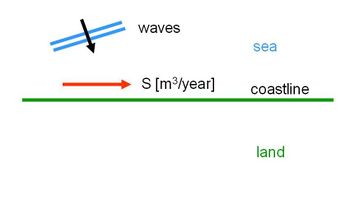Difference between revisions of "Sand by-pass systems"
(→Introduction) |
|||
| Line 6: | Line 6: | ||
{| style ="margin-left: 1em" align="center" style="text-align:center; font-size:85%" | {| style ="margin-left: 1em" align="center" style="text-align:center; font-size:85%" | ||
| − | |[[Image:Sand bypass Slide1.JPG| | + | |[[Image:Sand bypass Slide1.JPG|350px]] |
| − | |[[Image:Sand bypass Slide2.JPG| | + | |[[Image:Sand bypass Slide2.JPG|350px]] |
|- | |- | ||
|Valign="top"| Overtopping with low-head hydraulic turbine | |Valign="top"| Overtopping with low-head hydraulic turbine | ||
Revision as of 13:57, 30 August 2012
Introduction
Figs. 1 and 2 show two examples of pure natural stretches of sandy coasts. Fig. 1 reflects just a sandy coast with a net alongshore sediment transport.
Fig. 2 deals with a situation where a modest river flows out into the sea. Along the coast a net sediment transport is present in the right direction. In Fig. 2 two situations have been sketched; the present situation and the situation after a couple of years. Due to the river discharge and the net sediment transport at sea, the position of the mouth of the river shifts in the right direction with time. A long spit is formed between the sea and the left bank of the river. The river flows for some distance more or less parallel to the coastline. This process of shifting of the mouth of the river will not continue for ever. When the river becomes longer and longer the water level, say in point P in the river becomes higher and higher. At a certain moment the spit will break (at point P in the discussion) and a new mouth is formed farther upstream; the old mouth will close. The shift of the mouth resumes again; it is cyclic process with time.

|

| |
| Overtopping with low-head hydraulic turbine | Submerged oscillating bodies with hydraulic motor, hydraulic turbine, linear electrical generator. | |
The coastal processes as meant in Figs.1 and 2 occurred without human involvements for thousands of years.
Figs. 3 and 4 show the same cases as Figs. 1 and 2, but now with human interests. These human interests have become more and more relevant during say the last hundred years only. In the example of Fig. 3 ore has been found close to the coast; export of ore is a big opportunity for the economy; a large sea-port is required. Fig. 4 shows a situation where infrastructure like roads and buildings has been built in the coastal area. Often the river mouth is also used for navigation. The ever changing position of the mouth of the river is a serious draw-back in this area. One often likes to stabilize the position of the river mouth.
In stead of a port and a river mouth, used in this contribution as examples, also a tidal inlet of a lagoon could be chosen; similar considerations as given so far hold in that case.